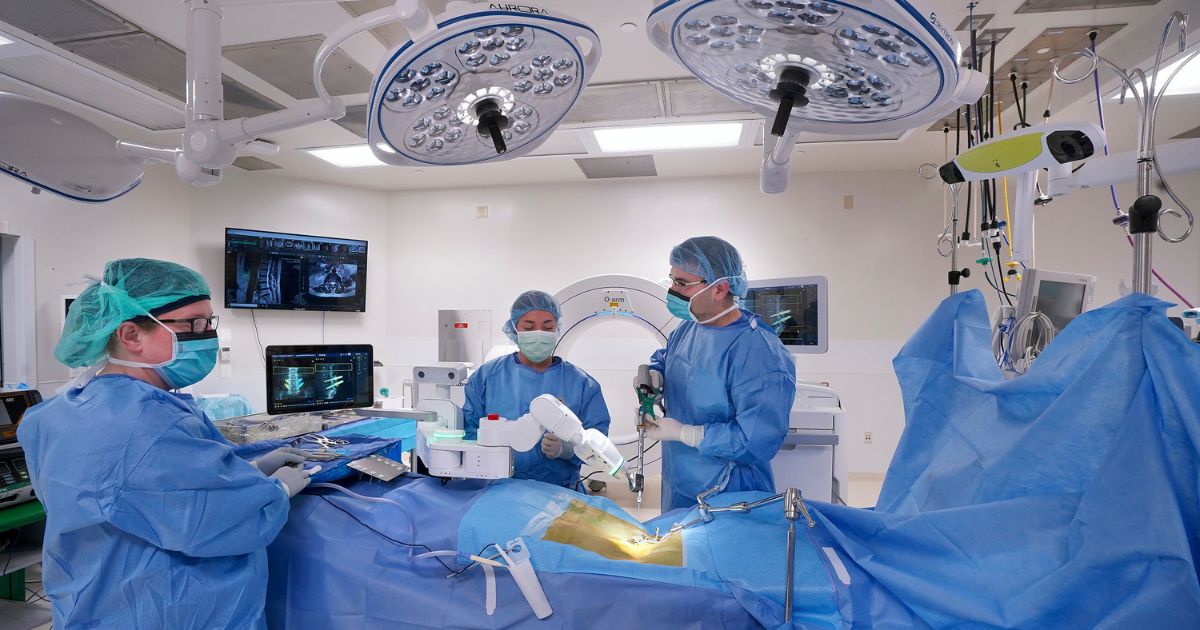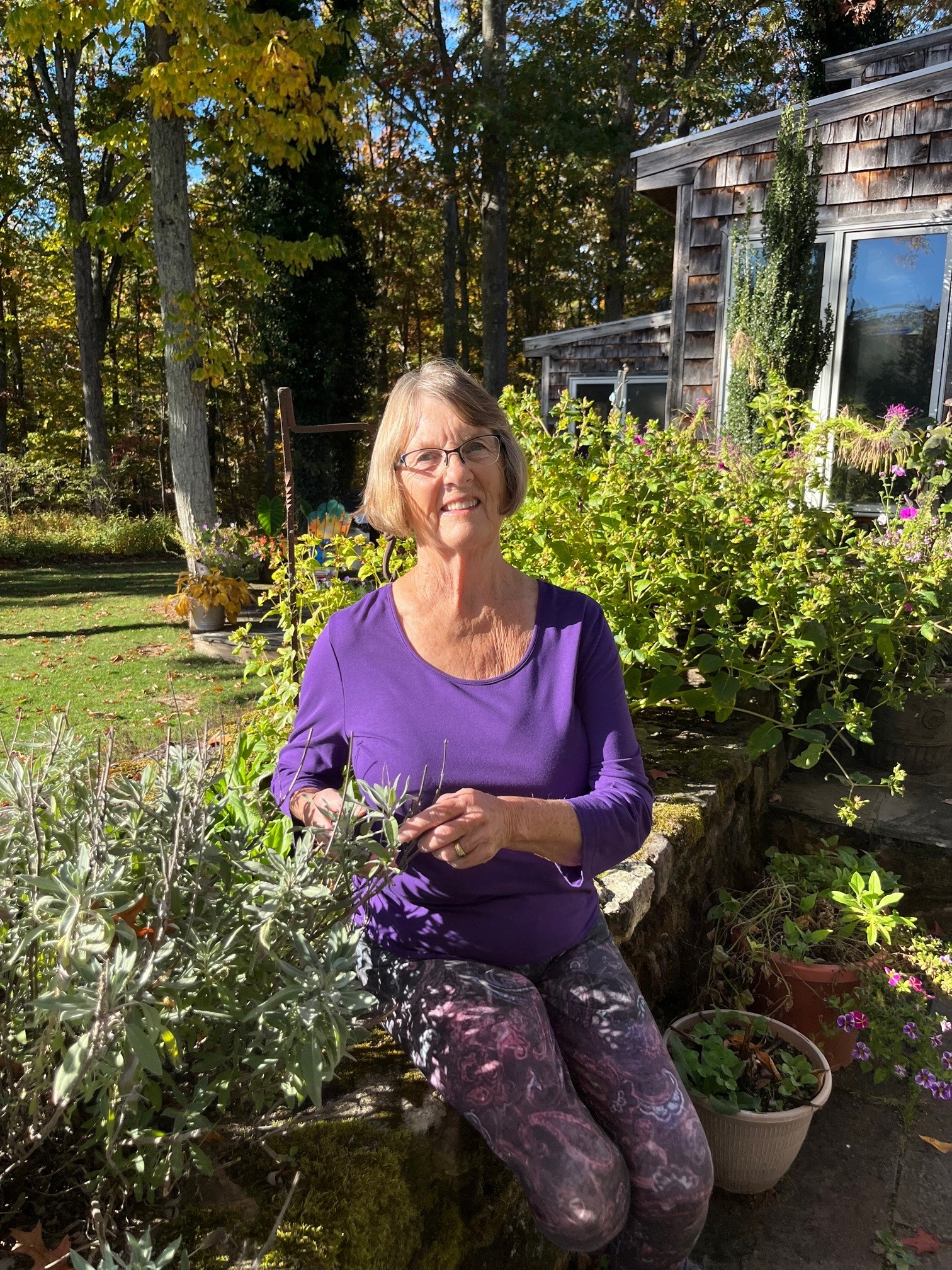Robotic Guidance Improves Minimally Invasive Spine Surgery
- Category: System Happenings, Did You Know?, Surgical Services
- Posted On:

At 72, Beverley Ridings refused to let chronic back pain slow down her life—whether it was teaching nursing students, tending her gardens or doing household chores. But after the pain, as she says, “really got my attention” last spring, Ridings became the first Winchester Medical Center patient to undergo minimally invasive spine surgery with the hospital’s new Mazor X Stealth™ Edition robotic guidance system.
Neurosurgeon Charbel Fawaz, MD, of Valley Health Virginia Brain & Spine, performed the procedure in October. He, along with his colleagues Patrick Ireland, MD; Joshua Prickett, DO; Lee Selznick, MD; and David Salvetti, MD, are all trained to use the Mazor. The system, Dr. Fawaz says, brings an unparalleled level of precision, customization and pre-surgery planning to the already proven benefits of minimally invasive spine surgery (MISS). “The Mazor navigation system minimizes post-operative pain and complications,” he says. “It also means less blood loss and shorter surgery times, which makes recovery easier and spine surgery possible for people who may not have been candidates in the past.”
Two weeks after her surgery, Ridings was doing great. “I’m walking over a half-mile to my mailbox and back. I do laundry. I cook. There’s just a little ache that creeps into my back at night. I use a gel ice bag for that. Once I’m up and moving for the day, there’s no need for any pain relief.”
Expert Neurosurgeon Joins Valley Health
Dr. Fawaz joined Valley Health Virginia Brain & Spine in March, bringing expertise in minimally invasive and complex multilevel spine surgery acquired during his neurosurgery residency at Canada’s University of Sherbrooke. Dr. Fawaz also received a prestigious fellowship in the spine program at the University of Calgary. He then served as chief of neurosurgery at The Moncton Hospital in New Brunswick, Canada, for ten years, from 2013 to 2023.
At Valley Health, Dr. Fawaz and other highly trained neurosurgeons treat emergency spine and brain trauma cases, tumors of the brain and spine, and more common conditions such as herniated discs, spinal stenosis and scoliosis. “Those are the spine conditions that affect people most often,” Dr. Fawaz says. “About 80 percent of the time, they can be treated with MISS.”
And if treatment involves spinal fusion—installing metal screws, rods, plates, cages or other material to stabilize the spine—Valley Health neurosurgeons can use the new Mazor system. In summer 2023, the Valley Health neurosurgery staff received extensive training on the system. Now, it is used increasingly often to guide MISS procedures for patients like Ridings.
“We have been utilizing spine navigation for several years very successfully here in Winchester,” says Dr. Salvetti. “This is the next step in advancing our technology to better meet the needs of our patients.”
Benefits of the Mazor System
A robotic guidance system, the Mazor helps neurosurgeons plan spine surgery more precisely using detailed CT images of a patient’s spine. “With Mazor, I can plan the safest angles for inserting screws, the best correction for a rod, and how to work around structures like blood vessels and the spinal cord,” Dr. Fawaz says. “We can simulate different solutions. Without Mazor, we would have to do this planning in the operating room during a procedure.”
Pre-planning with the Mazor can reduce operating time for a complex procedure from six or seven hours to five hours or fewer. That means less time under anesthesia, and it also makes spine surgery an option for people who otherwise might not be candidates due to advanced age, diabetes, heart disease or other conditions that could rule out a long procedure.
Mazor also provides navigation assistance during surgery. The system provides live images of the surgical site, and a special arm guides the surgeon in working at the precise entry points and angles set in their plan. “One of the most common questions we get is whether the robot performs the surgery,” Dr. Fawaz notes. “It’s a legitimate question. The answer is that I am the one making openings in the spine. It is my hands inserting the hardware, not the robot. The surgeon plans everything and then uses the guidance of the robot to execute the plan.”
The Mazor system can be used during open surgeries as well as during minimally invasive procedures. Adding robotic guidance to MISS provides unique advantages for patients, Dr. Fawaz says.
During a MISS procedure, the neurosurgeon makes small incisions and uses tools called tubular retractors to move apart fibers in the muscles surrounding the spine. Surgical tools are inserted through the tubes in order to reach the spine. In contrast, during an open procedure, muscle is often cut and moved aside. Avoiding cutting muscle makes recovery significantly faster and less painful, Dr. Fawaz explains.
The Mazor system also extends MISS benefits to fusion surgery, allowing the neurosurgeon to use small incisions to place screws and other hardware within the spine, all while using the system’s imaging and guidance to work precisely without making large incisions.
“Using the Mazor robot and the Medtronic software is like using GPS rather than a paper map when driving from point A to point B,” says Dr. Selznick. “It eliminates the guesswork and many of the hazards we have to contend with when doing it ‘the old-fashioned way.’ Having the capability of getting an intraoperative CT also takes away all of the guesswork and allows us to confirm good placement of the screws before the patient even wakes up. It’s a game changer for patient care.”
In addition to experiencing shorter surgeries, less blood loss, and faster recovery with less pain—meaning reduced use of pain medication—patients are also exposed to less radiation than with X-ray-guided procedures. Surgical results are more accurate, which can reduce the need for corrections in the future.
“Patients leave the hospital in half the time they would with an open procedure, sometimes the same day,” Dr. Fawaz says. “They are back to work, sports and other activities generally in four to six weeks.”
But it’s not just patients who benefit from the Mazor. The stereotactic navigation allows surgeons to operate without wearing a heavy lead apron, which is required when they use X-ray guidance.
“This means I no longer have to sacrifice my own back while fixing someone else’s,” Dr. Selznick says. “This could add years to my career simply by preventing the occupational hazard of radiation exposure and strain on my back.”
A Patient’s Experience
Ridings, who has her Master of Science in nursing, worked as a nurse in neurology at Winchester Memorial Hospital (the forerunner to Winchester Medical Center) before becoming a nurse educator at Laurel Ridge Community College in 2012. She says aging, plus heavy lifting on the job and at home, likely contributed to back and leg pain caused by a disc in her lower spine pressing on a nerve root. “I tried physical therapy, injections, non-narcotic medications and other modalities, but the relief was temporary,” she says. Doing the things she loves—teaching yoga, working out to Jazzercise routines, tending her gardens—left her with an aching back. “I could relieve it with stretching, but I wanted to do something more definitive. So last spring I saw Dr. Fawaz.”
With her background in neurology, Ridings was interested in the idea of robotic guidance for her procedure, which involved inserting screws and a cage in her spine to take pressure off the nerve. “Anything that minimizes the pain, time involved in recovery, and surgical trauma to the body is a positive thing,” she says. “Dr. Fawaz explained that instead of cutting muscle fiber vertically, they would tunnel through the fibers, which would make the discomfort and recovery time much less.”
After her procedure, Ridings spent one night in the hospital and then went home. “I took one prescription pain reliever pill,” she says. “After that, it was Tylenol for three days and a gel ice pack.”
Her husband took over the cooking and making the bed. “Turning over in bed and getting up from a chair were painful at first,” Ridings says. “But after the first 48 hours, things smoothed out a lot. Keeping up with physical exercise beforehand and having fairly strong muscles has helped me a lot. I think that would be helpful for others to know about, too.”
Looking back on her experience, she notes that “any time surgery can be minimally invasive, we are less apt to traumatize our bodies. And when it involves the nerves in the back and spinal cord, technology guidance and visualization increase the possibility of good outcomes.”
Dr. Fawaz agrees. “Now with robotic guidance, no one can do minimally invasive spine surgery better than we do at Valley Health,” he says. “We treat our patients the way we would want our own families treated, with the best options and safest technologies possible—right here, locally.”
_
To learn more, visit valleyhealthlink.com/VBSC or valleyhealthlink.com/neuro.


